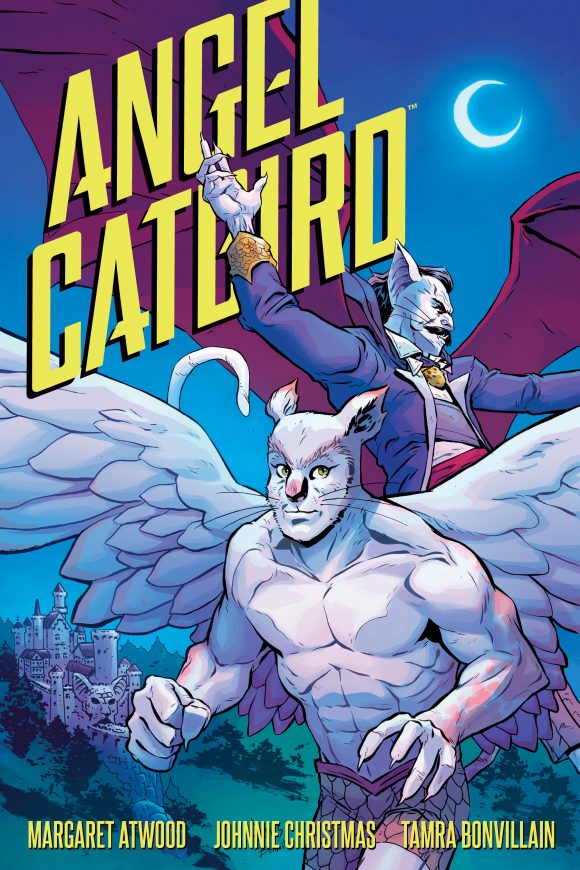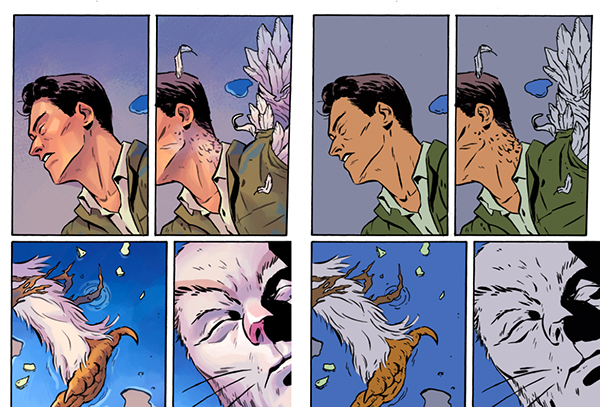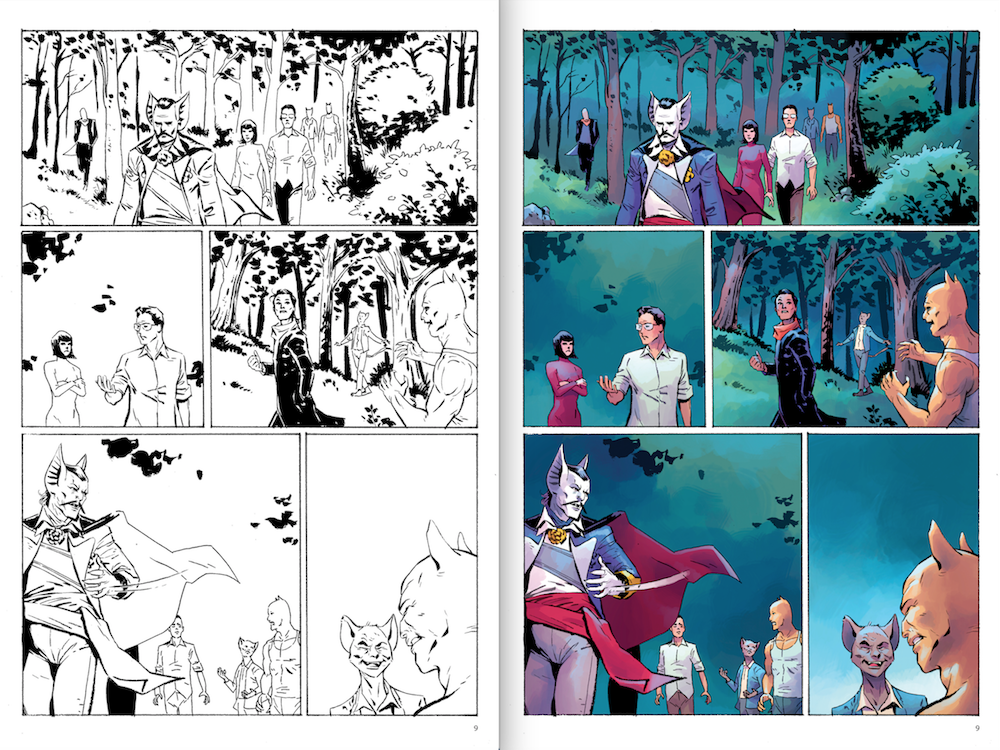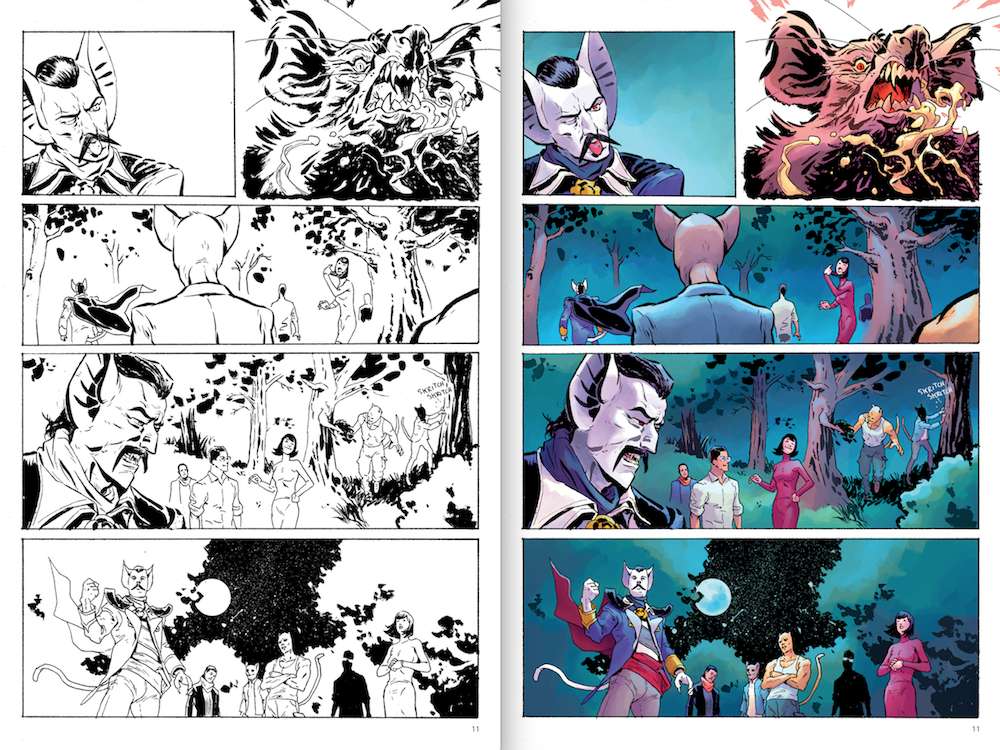An important skill that should not be taken for granted.

Volume 2
—
UPDATED 1/24/18: Hey, it’s Colorist Appreciation Day! Perfect time to re-present this piece by colorist extraordinaire Tamra Bonvillain. It was written in the context of her role in Margaret Atwood’s Angel Catbird but it’s universal — a great explainer on a grievously underappreciated aspect of comics art. Dig it. — Dan
—
For 13 THINGS I Learned From Writing Comics, by Margaret Atwood, Chuck Palahniuk and others, click here.
For Johnnie Christmas’ ANGEL CATBIRD Spotify Playlist, click here.
—
Over the last year or so, colorists have begun getting cover credits on comics, as well they should. They’re responsible for an intergral dimension to the storytelling even if people don’t necessarily understand — or even appreciate — what goes into it.
Tamra Bonvillain is one of the best in the business, with credits on a number of top books, including Margaret Atwood’s Angel Catbird, on which she enjoys major billing with line artist Johnnie Christmas. (The second volume of the three-part graphic novel is out from Dark Horse on 2/15. )
A few months back, letterer Nate Piekos put together 13 THINGS You Didn’t Know About Comic-Book Lettering. (Click here.) You guys dug it, so now we have Tamra here to explain her craft with 13 THINGS You Didn’t Know About Comic-Book Coloring:
—
By TAMRA BONVILLAIN
1. Comic book colorists are responsible for, well, the color obviously, but in such a way that helps clarify the storytelling. We use color and value to add prominence to certain elements and recede others based on what is most important; create or enhance the mood of a scene; and help lead the eye through a page.
2. Most colorists have assistants called “flatters” who do some of the preliminary work by separating all the different elements of a page using solid, flat color. There is no rendering at this stage, and usually, the colorist will change all the colors used to suit their palette. It’s basically an elaborate way of helping to color within the lines. Flats can take up to a few hours to complete per page, so flatters are enormously helpful getting the work out on time.

After and Before.
3. Comics are printed in a four color, CMYK process. C=Cyan, M=Magenta, Y=Yellow, K=Black. These three primary colors and mixtures of black combine to make all the possible colors available in print.
4. Colorists can work in either CMYK or RGB (R=Red, G=Green, B=Blue) mode. RGB is what screens and TVs use to display color. Because RGB is light-based instead of pigment-based like CMYK, there is a large gamut of color that is not possible to print as it appears on screen. Colorists can work around this on screen by turning on a preview of what the image will look like in CMYK, which is more accurate to the printed copy. There are strengths and weaknesses to both processes, and it just comes down to personal preference.

5. Colorists today work almost exclusively digitally. Color used to be done by hand, and could be complicated and time consuming. Because of this, color was often more simplistic and color choices were limited. It is still possible to color traditionally, but the demands of the monthly comic schedule often make it more convenient to work digitally, which is much easier to tweak and change.
6. Most comics are colored digitally in Adobe Photoshop. It’s possible to color in other art programs, but Photoshop has such a wide array of tools and is well suited to preparing art for press, that every professional colorist I know uses it.
7. Photoshop, and other art programs, have a thing called layers, which lets you draw on kind of a digital overlay that sits on top of lower layers. This gives colorists the ability to make changes and additions without losing the work beneath, and they can be shuffled around. Some colorists prefer to use minimal layers, and early in digital coloring, computers were not as powerful as they are now, so it was often a necessity to limit the number of layers.

8. While it can be very helpful to communicate with the writer, artist and other members of the team when coloring a book, often the people working on a book have limited interactions with one another, and it’s not uncommon that they’ve never met in person. Everything is sent and received digitally for the most part nowadays, so back and forth emails may be the only interaction the team on a comic has with one another.
9. Working as a colorist can often feel like you’re a kind of middle manager. As I mentioned before, we have flatters that help us set up pages, and some colorists use additional assistants. You receive pages from your artist or editors, then you get those pages ready for flatters, get those pages in, send them out to your assistant(s). All this has to be done juggling your flatters’ and assistants’ schedules, and keep enough pages flowing so they come back in time for you to color and finish the book on time. You also have to handle billing information for paying all the people assisting you on a book. It is helpful and time saving in the long run, but it can be a bit difficult to keep all these different wheels spinning and stay productive.

10. Colorists can often get pages right up to the last second of a deadline. Ideally, colorists want pages as early as possible, but sometimes things don’t work out. Art comes in later than expected, but the deadline has not changed. We have to make up that time as best we can. This can be a challenge, especially taking into account the last point about keeping flatters and assistants working.
11. Time spent per page can vary wildly. It all depends on the style and level of detail of the artwork, the style of the coloring, and the speed of the individual doing the work. From personal experience, some books on the low end average about two hours per page, while more complicated books can take four or more hours per page.

12. There are a wide range of ways to color, and colorists have unique and identifiable styles. Generally speaking, there are flatter styles of coloring with minimal rendering; there can be soft, airbrushy rendering; or more painterly rendering. The way a colorist handles color, be it more naturalistic or expressive, favorite palettes, etc., can also vary a great deal. A colorist with a defined style can be recognized just as easily as a penciller’s art style.
13. Colorists deserve credit as part of the creative team. Some people view colorists as interchangeable, but each person brings a unique perspective and aesthetic to the book, and the audience would experience that book differently if colored by another colorist. It is my view that if the art is meant to be presented in color, then it is not complete until the colorist has finished their work, and we deserve to be recognized for our contribution.
—
The second volume of Angel Catbird is out from Dark Horse on 2/15.
For 13 THINGS I Learned From Writing Comics, by Margaret Atwood, Chuck Palahniuk and others, click here.
For Johnnie Christmas’ ANGEL CATBIRD Spotify Playlist, click here.
—

Trackbacks/Pingbacks